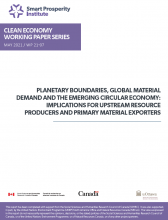While in recent years climate change and biodiversity loss have been Canada’s environmental policy priorities, globally these issues are increasingly seen as symptoms of a broader problem of overuse of resources (e.g. fossil fuels, biomass, construction materials, water, land and energy) and lack of attention to the impacts on the environment, such as pollution, this causes. The “Circular Economy” (CE) is a conceptual model that has begun to emerge in business, policy, and civil society discussions as a response to these challenges. At its ideal, the vision for a CE is one where the needs of an increasingly populous and wealthy global society can be met within the safe boundaries of key ecological systems and processes. CE thought leaders, such as the Ellen MacArthur Foundation, offer three core principles to enact this vision: i) waste and pollution are designed out the economy; ii) products and materials are kept in use; iii) natural systems are regenerated and enhanced.
While global research and policy interest in shifting to a CE are accelerating, early strategic thinking and policy development on the CE have been led by resource importing economies, and perhaps for this reason have a downstream focus on closing the loop for materials now flowing out of the economy as ‘waste’. Primary resource sectors and producers have mainly been left on the periphery of CE research and policy discussions, as flows simply ‘to be minimized’. While reducing the flow and intensity of primary material inputs and waste generation in any given sector or region is indisputably a central tenant of an effective CE transition, the relevance of globally emerging CE policy discussions for economies with significant primary resource-producing sectors, such as Canada, but also many emerging economies in the Global South, is accordingly not well researched or understood. This knowledge synthesis report has sought to fill that gap, and to address increasing interest in knowledge and data generation around the implications for a shift towards more CE strategies in global markets for resource-producers.
READ THE WORKING PAPER: Planetary Boundaries, Global Material Demand and the Emerging Circular Economy: Implications for upstream resource producers and primary material exporters
This report has been completed with support from the Social Sciences and Humanities Research Council of Canada (SSHRC). It was also supported, in part, by the United Nations Environment Programme (UNEP) North America Office and Natural Resources Canada (NRCan). The views expressed in this report do not necessarily represent the opinions, decisions, or the stated policies of the Social Sciences and Humanities Research Council of Canada, or of the United Nations Environment Programme, or of Natural Resources Canada, or of any other project partners.



